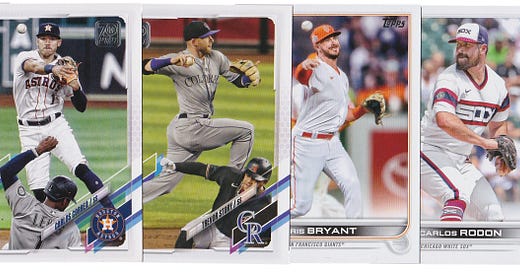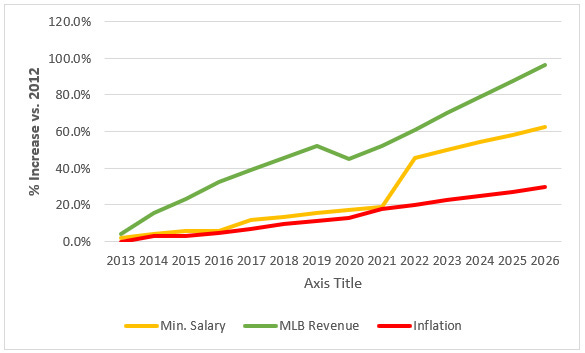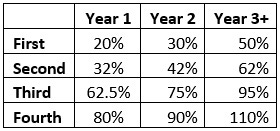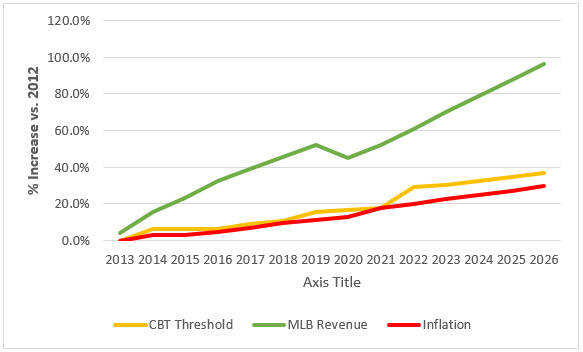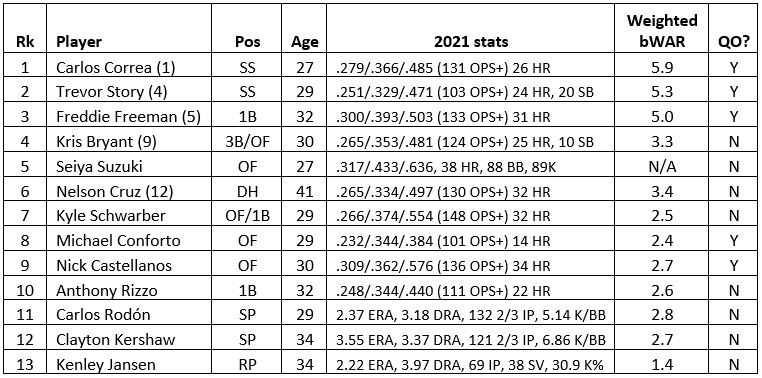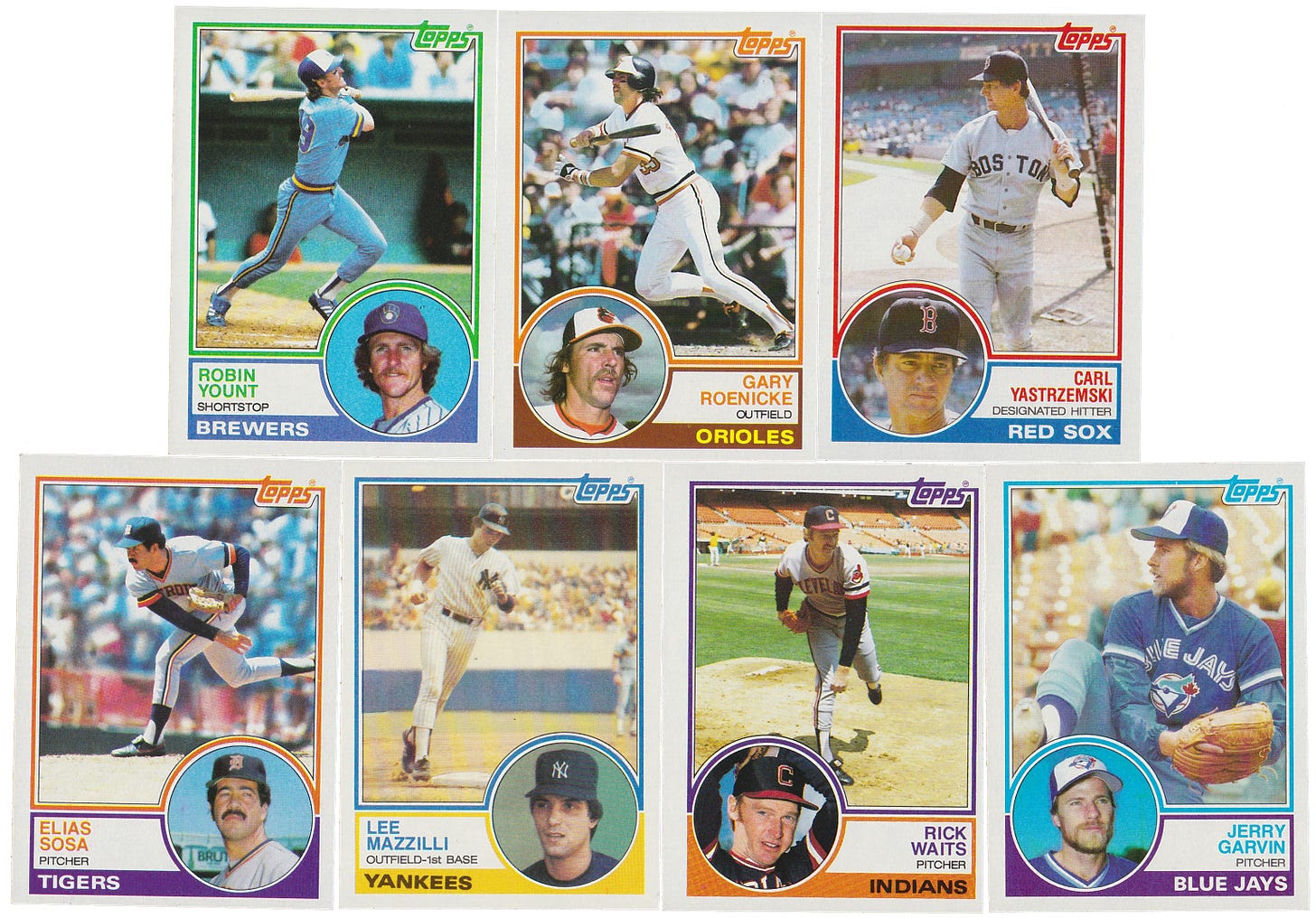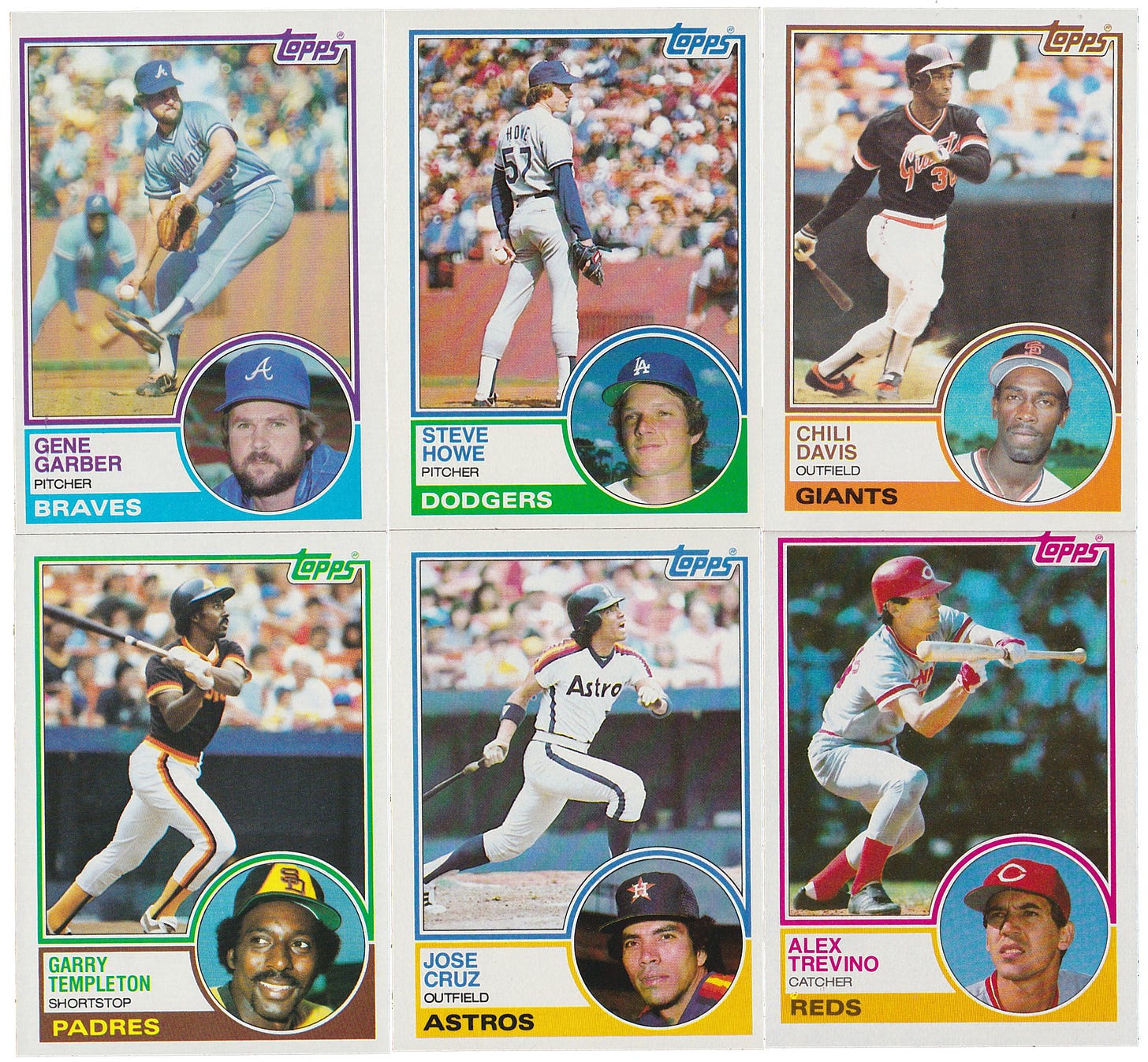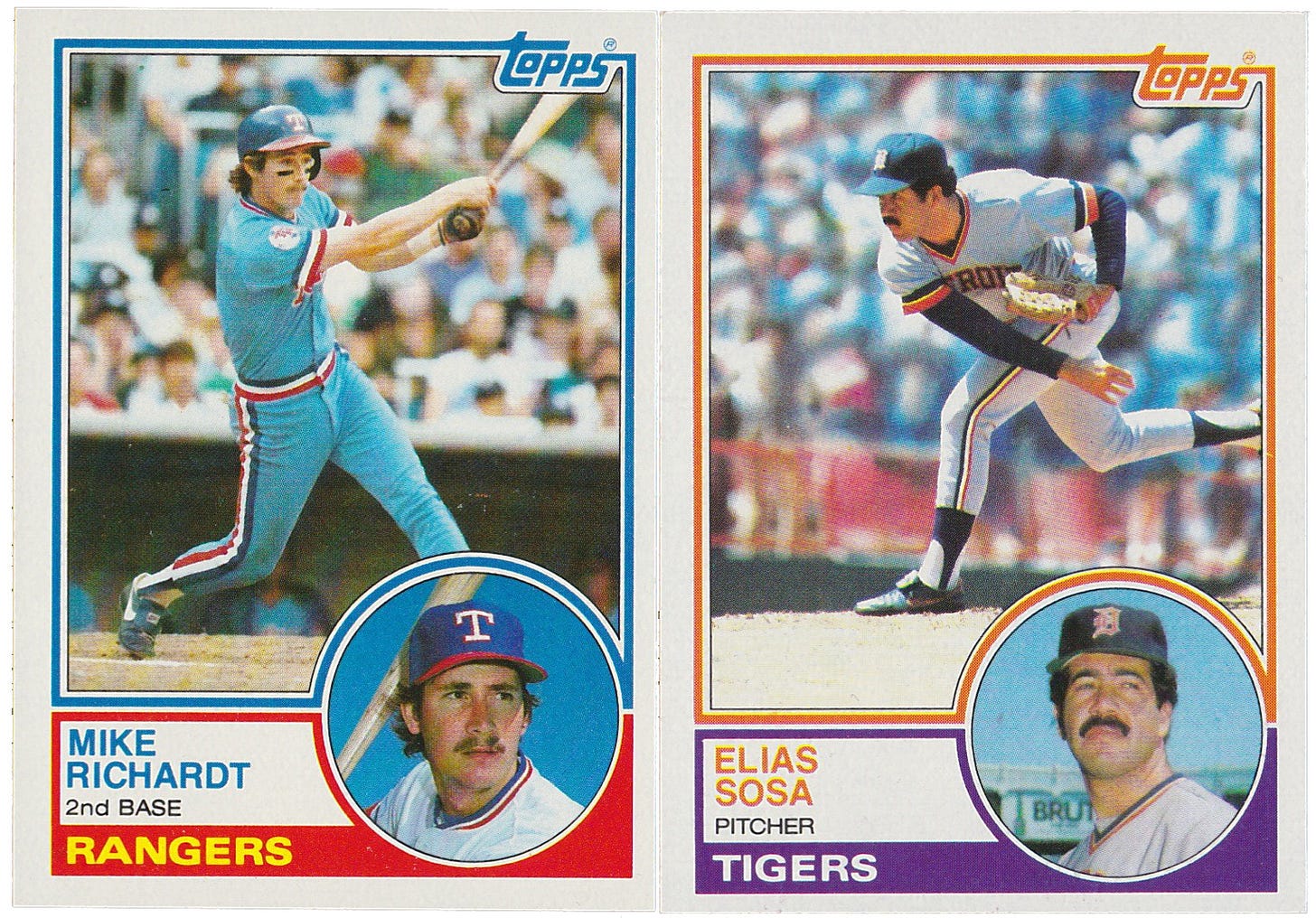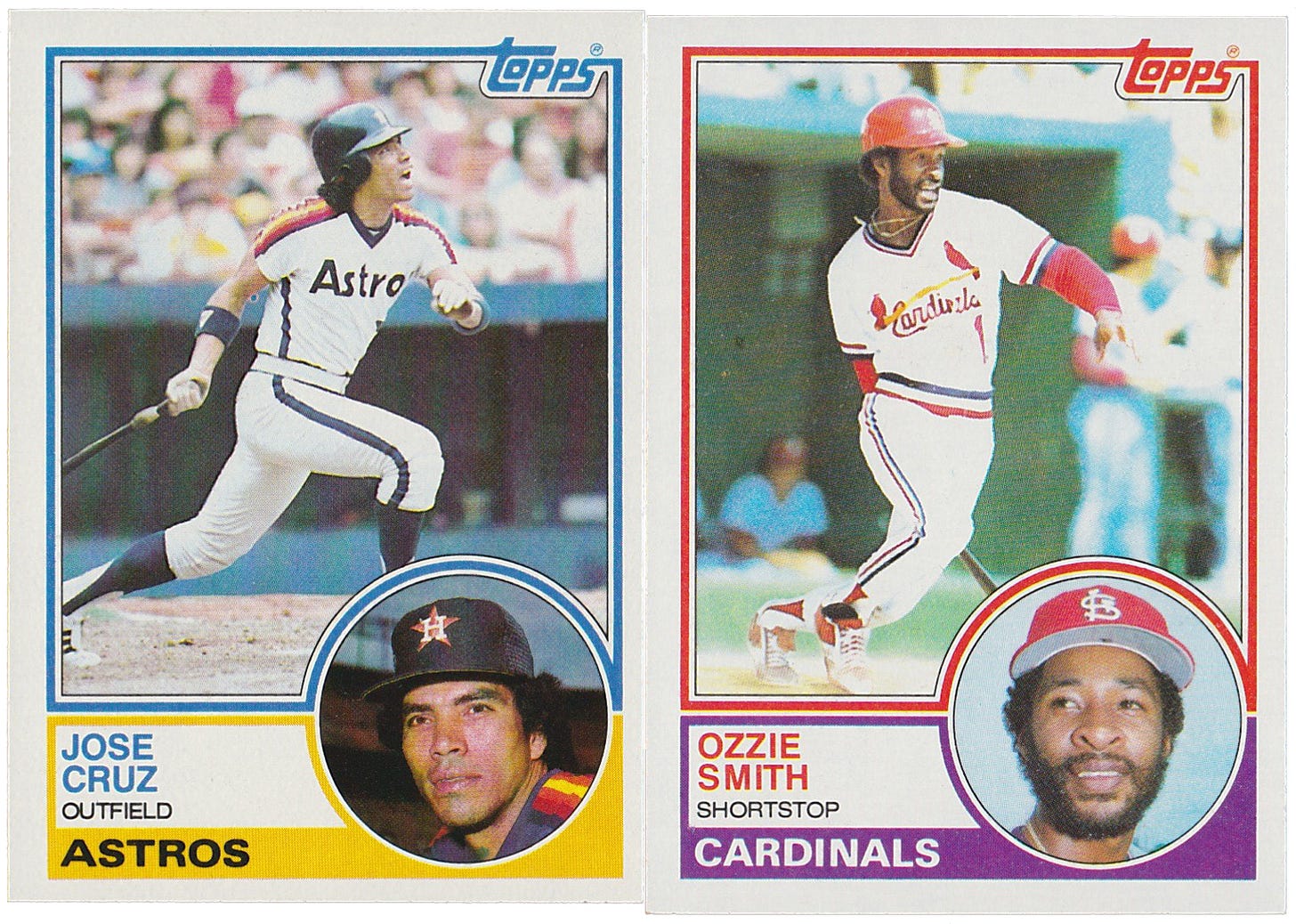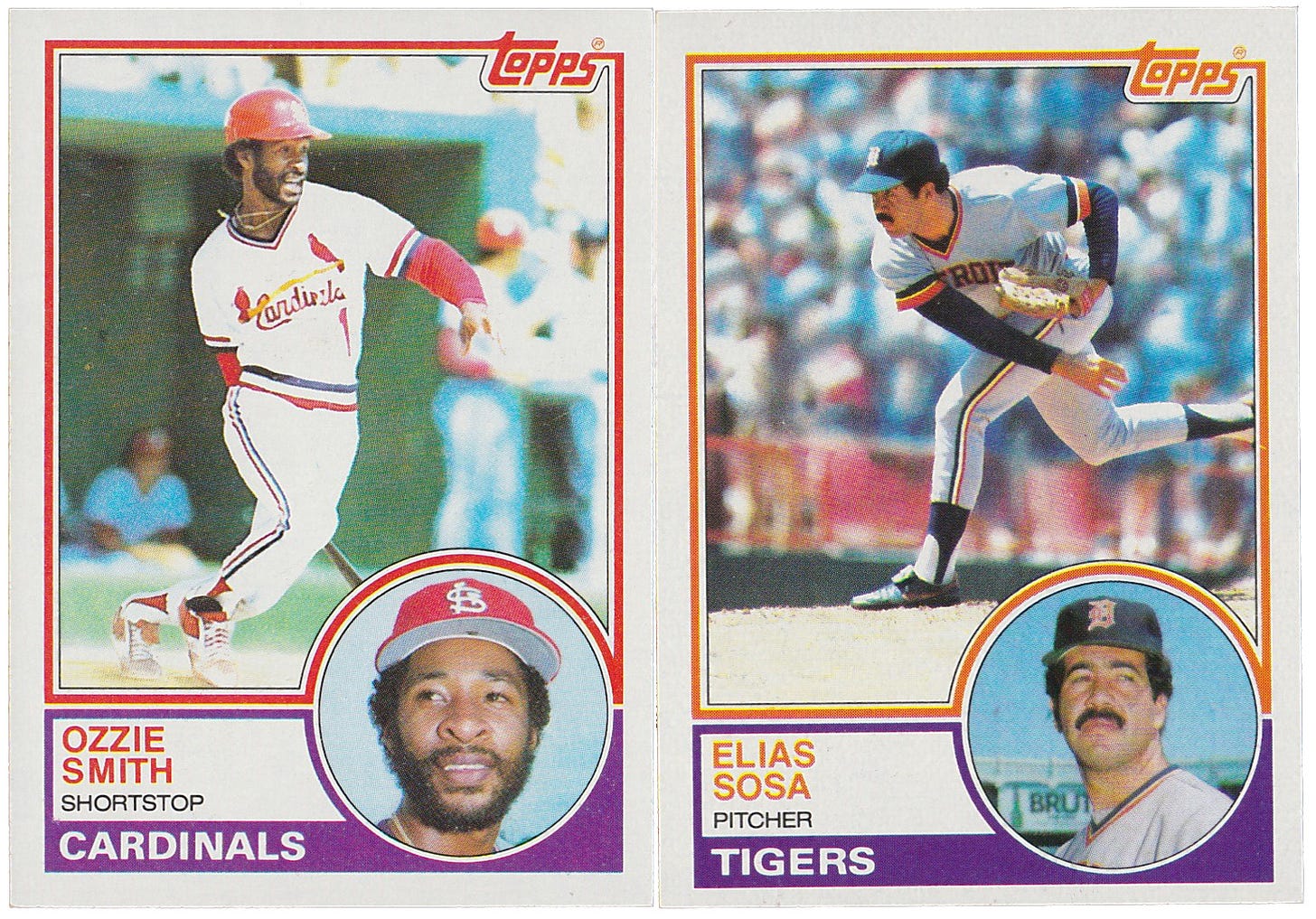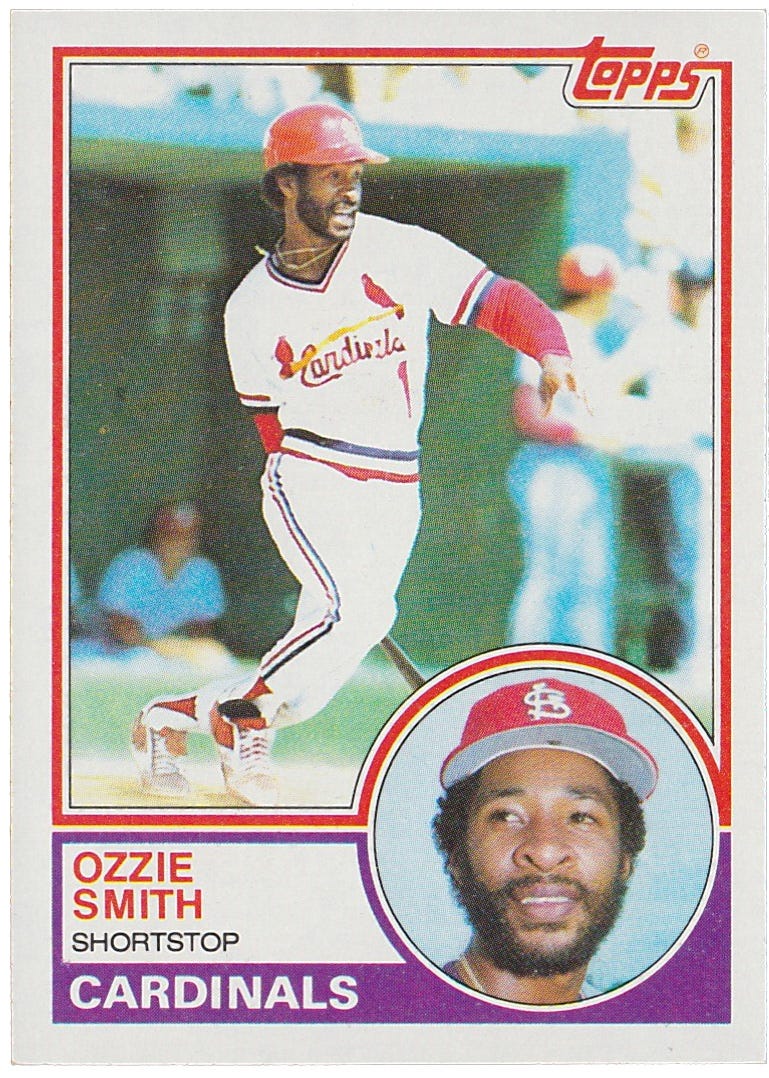The Cycle, Issue 122: Play Ball!
The lockout is over! What happens now, breaking down the new CBA, checking in on the unsigned free agents, plus MLB's streaming deals, Canada's vaccine requirement, the best Topps card of 1983 & more
In this issue of The Cycle . . .
Play Ball!: Parsing the new CBA, plus what you need to know about how the remainder of the offseason, Spring Training, and 2022 season will proceed from here
What Else You Need to Know: MLB’s new streaming deals will make it more expensive watch baseball’s best games, Vaccines will be required for players in Blue Jays’ home games
Free Agent Frenzy: A reminder of how many players remain unsigned and which big names are still available
Pop of the Topps: Finding the best Topps card of 1983
Feedback
Closing Credits
Play Ball! Disaster Averted, So Now What?
The lockout is over. The players and owners came to terms on a new Collective Bargaining Agreement on Thursday, with the players voting to accept the owners’ last offer Thursday afternoon, and the owners voting unanimously to ratify the new agreement early Thursday evening.
So what happens now, and what’s in the new agreement? Let’s break it all down.
First, all of the lockouts restrictions have been lifted. That means that, starting today, players in the union can report to camp, injured players can get back in touch with their teams’ training staffs, free agents can sign major-league contracts (more on that below), the trade market is back open. Everything that couldn’t happen for the last 99 days because of the lockout can now happen again.
Officially, the mandatory reporting date for major-league Spring Training is this Sunday, March 13, and the exhibition schedule is expected to begin late next week, on March 17 or 18 depending on the team.
Most significantly, despite the commissioner’s grandstanding, no regular-season games will be missed. The 2022 season will be a full 162 games. Opening Day has been pushed back to April 7, but the two series scheduled for before then will be made up. One of those series will be added to the end of the season, extending the regular season by three days. The other will be made up via doubleheaders.
Also, this offseason’s Rule 5 draft has been canceled, and the deadline for players and teams to exchange arbitration figures is now March 22 (a week from Tuesday), with hearings to follow and potentially spilling into the regular season.
Those are the big adjustments to the calendar. As for the contents of the new CBA, in broad terms my early impression is that this agreement is a favorable one for the league’s younger, pre-arbitration and pre-free-agency players, but doesn’t do much to alter the conditions for the league’s veterans and higher-paid players. It’s definitely a compromise for both sides. The owners gave up significant ground with regard to those less-experienced players, but largely held the line at the upper levels and got several items on their wish list, and a potential path to others.
For the fans, beyond the elation of getting a full season and not having to deal with another labor dispute for at least five years, it’s a bit of a mixed bag. Some things I didn’t like are gone, but many other things I don’t like are coming, and the game is going to look very different in some very obvious ways when it resumes in April. Let’s break it all down.
CBA #13 (2022–2026)
Designated Hitter
The DH will now be in use in both leagues.
My take: I’m sure I’ll be nostalgic about pitchers hitting from time to time, but only in the same way that I’m nostalgic about rotary telephones. Verdict: Good
Postseason
The playoffs have been expanded to include 12 teams, three division winners and three wild-card teams in each league. The wild-card round will be a best-of-three series with all games hosted by the higher seed. The two division winners with the best records in each league will have byes for that round, and the teams will not be receded thereafter, giving the playoffs a pure bracket structure. Also, tiebreaking regular-season games have been eliminated. All regular-season ties will be broken by seeding formulas.
My take: Lowering the bar for access to the postseason is bad. Eliminating tie-breaker games, which are almost always fun and memorable, is bad. I do like expanding the wild-card round beyond one game, but that’s not enough to salvage this, which is an obvious cash grab by the owners and will disincentivize team building by lowering the bar for entry to the postseason and treating one of the three division winners like another wild-card team. Verdict: Bad
On-Field Rules
Doubleheader games will once again be nine innings. The automatic runner in extra innings is eliminated. No other rule changes, beyond the designated hitter, have been put in place for 2022, but the league can now implement rule changes with just 45 day’s notice upon approval by an 11-member committee that has six members appointed by the league (the other five include one umpire and four union representatives).
My take: For 2022, this is great news. For 2023 and beyond, it could be very bad, depending on your opinion of the pitch clock, limitations on shifting, and larger bases, which seem to be Rob Manfred’s top three priorities. I’ve softened on the pitch clock and understand the need for larger bases, but I loathe the idea of limiting shifting. It seems that’s a battle to be fought another day, however. Verdict: Mixed
The Draft
The top six picks in the annual Rule 4 amateur draft will be determined by a lottery with limits on how many consecutive seasons teams can participate in the lottery determined by whether or not they receive or pay into revenue sharing. The draft has also been cut in half, from 40 rounds to 20.
My take: I’m still not clear on all of the details about how the lottery will work, but it seems like an improvement in the abstract. I know many are skeptical that this will be effective at undermining tanking, but I think it does remove an incentive for teams to completely strip their major-league rosters during a rebuild in the style of the recent Orioles teams. I don’t like the reduction of the overall draft length, however. That’s all part of Rob Manfred’s ongoing efforts to shrink the minor leagues, which I find cruel and contrary to the game’s interests. Verdict: Mixed
Minimum Salary
The major-league minimum salary will jump to $700,000 this season and increase $20,000 annually to $780,000 in 2026. There are also increases to the minimum salaries of minor-league players who are on 40-man rosters.
My take: The players did very well here. Let’s go back to my graphs comparing the rate of increase of the league minimum since 2012 relative to league revenues and the cost of living (bearing in mind that the revenue and cost-of-living figures for 2022 and beyond are projected based on past trends):
That’s a significant correction that gives those pre-arbitration players something much closer to the share of league revenues they had prior to the CBA put in place after the 2011 season. Verdict: Good
Competitive Balance Tax
There will now be four tiers of this tax (there had previously been three). The lowest threshold will start at $230 million this year and increase to $244 million in 2026 and will carry the same penalties as in the previous CBA, including higher tax rates for teams that exceed a given threshold in consecutive seasons. The other three thresholds will be placed at $20 million intervals above the initial threshold with increased penalties for each and a particularly large jump in the tax rate at the third threshold. The highest rate will be a 110 percent tax for a team that exceeds the top threshold for three or more consecutive seasons. It does not appear that there are any draft-pick penalties for exceeding the thresholds. Here are the tax rates for exceeding each threshold:
My take: The players did well to keep MLB from increasing the penalties and (it seems) eliminate draft-pick penalties. However, the thresholds do not increase sufficiently, and that added top tier places an additional barrier to free spending. Here’s how the new initial thresholds look in that graph:
That yellow line should track with the green one, not the red one, particularly given that these are just upper limits, not guaranteed salaries like the major-league minimum. Verdict: Bad
Pre-Arbitration Bonus Pool
This CBA establishes a $50 million bonus pool to reward the top-performing players not yet eligible for arbitration. Bonuses will be distributed based on awards voting and wins-above-replacement totals. Eligible players will receive $2.5 million for winning the MVP or Cy Young award, $1.75 million for finishing second for those awards, $1.5 million for finishing third, $1 million for finishing fourth or fifth or making the All-MLB team, $750,000 for winning the Rookie of the Year, and $500,000 for finishing second in the Rookie of the Year voting or making the All-MLB second team. Players can receive just one bonus per season. Pool money not handed out for those awards will be distributed to the 100 eligible players with the highest WAR totals as determined by a committee composed of union and management representatives, which will also determine which version of WAR, or what formula combining multiple versions of the stat, to use to determine the top 100 players.
My take: Broadly speaking, more money to deserving pre-arbitration players is a very good thing, but there could be devils in the details here. There are conflict-of-interest risks in tying this to awards voting as well as to WAR statistics, which are formulated and regularly tweaked by individual statisticians. Also, it seems the pool money will count against the luxury tax, but will do so equally for all teams, which means it effectively lowers all of the CBT thresholds by $1 2/3 million. This is a big win for the players, but it could be messy and will likely need some fixing in the next CBA. Verdict: Good?
Service Time Awards
This is another entirely new feature in this CBA. Per this provision, top-100 prospects who finish first or second in the Rookie of the Year voting will be rounded up to a full year of service time for that season, even if they debuted after the cutoff. Similarly, top-100 prospects that finish in the top three for Rookie of the Year or top five for Cy Young or MVP will earn their teams additional draft picks.
My take: First, we don’t know what list (or lists) are being used to determine who is or isn’t a top-100 prospect, but there’s less risk of conflict of interest there because those lists come out in January, long before any of the awards voting that would trigger one of the above awards and, at that point, every one of those top 100 prospects is a longshot to qualify. The conflict-of-interest risk for the awards voters, however, is arguably even higher, however, as a full year of service time that allows a young star to reach free agency a year earlier than he otherwise would have is worth far more than the $2.5 million of the top pre-arbitration bonus. In many cases, it is worth an eight-figure sum.
As for the intent of deterring service-time manipulation, I’m not convinced this is going to do much. If anything, it could increase the incentives to keep top prospects in the minors, because the later a team calls up a prospect, the less likely he is to rank highly in the awards voting.
Consider Wander Franco, who was great after his promotion last year, but only finished third in the Rookie of the Year voting because he didn’t debut until June 22, a date likely influenced by the Super Two cutoff. This new rule would only have incentivized the Rays to wait longer to call up Franco, to make sure he didn’t get that full year of service time for a half a season.
Similarly, a top-100 prospect is worth far more than any sort of supplemental draft pick, so that isn’t likely to be enough incentive for a team to give a prospect a full year in the majors when they might otherwise have limited his service time to delay his free agency.
The union seems vaguely aware that this could backfire, as they have retained the right to eliminate this provision before the new CBA expires. Verdict: Bad
Optional Assignments
Players with options remaining can only be optioned to the minors five times in a single season without being placed on waivers.
My take: Five is still a lot, but there was no limit before, and this will eliminate the most extreme shuttling of marginal major leaguers. Verdict: Good
Schedule
Starting in 2023 every team will play every other team, in both leagues, every year. Intra-division games will be reduced to compensate for the extra interleague games.
My take: This goes hand in hand with the expanded playoffs. If you’re going to devalue division titles by having three wild cards and treating the division winner with the lowest record like one of the wild-card teams, you should reduce the number of intra-division games and play a more balanced schedule so that mediocre teams in weak divisions don’t have an advantage. I don’t mind every team playing every other team, either. If you’re going to have interleague play, let’s have the Yankees and Dodgers play every year. Let’s let every fanbase see their team go up again against Trout and Ohtani, or against the defending champions. Give every fanbase a chance to see Juan Soto hit, or to face whoever this year’s exciting new star may be. We don’t need 19 Diamondbacks-Rockies games every year. We don’t even need 19 Dodgers-Giants games every year. Verdict: Good
International Play
Over the next five years major-league games or tours will be played in Mexico, Puerto Rico, the Dominican Republic, Asia, London, and Paris.
My Take: These can be a bit awkward, but I think they’re good for the game, and I’m particularly excited to see the Dominican Republic on the list. Mexico, Puerto Rico, Japan, and London have all hosted major-league games, as has Australia, but the Dominican Republic, which has contributed so much to the sport, has not. That will be corrected during this CBA. Verdict: Good
International Draft/Qualifying Offer
The owners inexplicably linked these two late in the negotiations, demanding an international draft in exchange for eliminating the qualifying-offer system of free-agent compensation. The players, following the lead of their Latin American members, oppose the international draft, but recognizing that this was a poison pill slipped into the deal late in the negotiations, managed to punt on the two issues. Setting a July 25 deadline to either adopt an international draft and eliminate the qualifying offer or to leave both systems as they were under the previous CBA.
My take: First, this is an absurd pairing by the owners. The qualifying offer impacts a handful of already established (and rich) major leaguers every year. An international draft would restrict the rights of every amateur player in the world outside of the United States and Canada. They are not equivalent issues.
Second, I won’t claim to be an expert on the potential impacts of an international draft. We should listen to the players and reporters from countries such as the Dominican Republic and Venezuela, which are most likely to be impact by such a draft, as well as those from Puerto Rico, which was included in the domestic draft in 1989 and thus can best speak to the impact of such a change. Fernando Tatis Jr. said that an international draft would “kill baseball” in the Dominican Republic. David Ortiz told ESPN’s Jeff Passan on Wednesday that it would take the D.R. three to four years to properly implement a draft. The Athletic’s Maria Torres and Ken Rosenthal did a deep dive into the issue in January.
At the very least, this is something that should be managed carefully, slowly, and in collaboration with representatives of the countries that will be most effected. I’m not sure even the July 25 deadline allows enough time for any of that, particularly given how chaotic things are going to be in baseball in the near term, but at least the players didn’t cave on the issue.
As for the qualifying offer, free-agent compensation does have one benefit, it incentivizes teams to keep their pending free agents rather than deal them at the deadline. As I understand it, some form of draft-pick compensation would continue even without the qualifying offer, but it would not penalize the signing team, as the QO system does. I don’t like the way the QO works as a drag on the market value of second-tier free agents, but I see it as a very minor issue as compared to the international draft and it seems the union recognized that getting the draft issue right is more important than eliminating the QO. Verdict: Good
Uniform Ads
The players have given their permission for ads on uniforms and helmets.
My take: [expletives deleted] Verdict: Awful
I should note that, to get the agreement done, the union agreed to drop its $500 million grievance accusing the league of bargaining in bad faith when negotiating the length of the abbreviated 2020 season. I don’t know whether or not to count that as part of the CBA, as it’s not something that will govern the game going forward, but it does mean the league will not be held to account for its bad-faith bargaining, more of which we saw during these negotiations. The repercussions of that decision will be difficult to pin down, but they are troubling, particularly if you believe that the league insisted that the grievance be dropped because it was worried it might succeed. The $500 million was the alleged loss in salaries from the extra 20 games per team that the union thought could have been played in 2020 if not for the league’s misbehavior. The union’s 2018 grievance alleging that the A’s, Marlins, Pirates, and Rays embezzled revenue sharing money rather than using it to improve their teams, an allegation that strikes me as much more difficult to prove, will continue.
What Else You Need to Know
MLB Sells Marquee Games to Streaming Services
I’ve written way too much already in this issue, so I have to make this quick. Earlier this week, Apple TV+ and NBC/Peacock announced they had struck deals to stream regular-season MLB games that will be exclusive to their service and not available on MLB.TV or on the respective teams’ local networks. Apple TV+ signed a seven-year, $595 million contract to stream two marquee games every Friday night. NBC/Peacock signed a two-year, $60 million deal to stream games on Monday and Wednesday nights, picking up those games omitted from the new ESPN contract signed last May. It’s not yet known if the NBC games will be behind Peacock’s paywall (or, if so, how many of their games will be), but the bottom line for fans is that, if you want to see all of your team’s games, you’ll likely need a subscription to both services, which is a total of roughly $10 per month, pending any price hikes in the wake of these deals, in addition to whatever you pay for the basic or sports-tier cable to get the bulk of your team’s games (plus the FOX, ESPN, MLB Network, and TBS broadcasts) and, for out of market fans, MBL.TV.
Meanwhile, MLB’s national television contracts are now worth an average of $1.96 billion per year, which works out to more than $65 million per team annually, which is more than the payrolls of the Pirates, Orioles, Guardians, and Marlins. That’s before factoring in local TV revenue or any other revenue beyond TV rights. All 30 teams should have the phrase “we can’t afford” struck from their vocabularies.
Vaccinations Required for Players at Blue Jays Home Games
Canada requires all visitors to be vaccinated for COVID-19. That includes professional athletes in town for a three-game series at Rogers Centre. That’s an interesting wrinkle for a season in which 19 teams (the 15 in the American League plus the Reds, Phillies, Cardinals, and Cubs) have games scheduled in Toronto. Even more interesting, the new CBA has a provision that players who are unable to travel to a game due to their vaccination status will be placed on the restricted list, which means they will receive neither pay nor service time for those games. This is from a league in which only 24 of 30 teams reached the 85 percent vaccination threshold for reduced COVID protocols last year.
Personally, I’m more than fine with that provision. Vaccination requirements for travel date back to smallpox vaccine requirements in the 1940s and have been a common feature of international travel to certain parts of the world ever since. The COVID-19 vaccines have been fully approved by both the U.S. Food and Drug Administration and Health Canada and are safe, effective, proven to be life saving, and are an essential tool in combating what is still an ongoing pandemic with current case rates in the U.S. comparable to mid-summer 2021 and 2020. I’ve had all three of my shots and am eager to get a fourth when eligible. I’m also very curious to see how this whole thing plays out once the Blue Jays return home to Toronto.
Also:
Marlins RHP Sixto Sánchez, who had shoulder capsule surgery last July, isn’t expected to return before midseason.
Cubs reliever Codi Heuer had Tommy John surgery earlier this week, will miss the entire 2022 season.
Former Cardinals lefty Kwang Hyun Kim has returned to the Korea Baseball Organization via a four-year deal with his former team, now known as the SSG Landers.
The Rockies fired the head of their nascent analytics department, whom they had just hired in September.
Rockies pitching prospect Riley Pint, the fourth-overall pick in the 2016 draft and a central figure in Jeff Passan’s 2016 book The Arm, unretired and has rejoined the team.
Mike Trout, Anthony Rendon, and Shane Bieber claim to be back to 100 percent.
Former Dodgers lefty and 2002 NL All-Star Odalis Pérez died on Thursday at the age of 43 after falling off a ladder at his home in the Dominican Republic and hitting his head.
Free-Agent Frenzy!
Baseball is back. Spring Training starts on Sunday, and 125 major-league free agents remain unsigned. Included among that group are some of the game’s biggest names, such as Freddie Freeman, Carlos Correa, Kris Bryant, and Clayton Kershaw, as well as numerous other players who could dramatically impact the outlook of their 2022 teams.
That total of 125 players is derived from the list of XX(B) free agents released by the Major League Baseball Players Association in early November and supplemented by the players whose options were not picked up or who were non-tendered later that month. Not all of those players will find teams in short order, not all will find teams at all, and some who do will have to settle for minor-league deals, but the majority of them will sign major-league deals, which means we’re likely to see 60-plus such contracts handed out in the next week or so, some of them stretching into nine figures.
Remember the chaos that preceded the lockout in late November? This is going to be even crazier, because the trade market is going to move at the same time. I prefer not to speculate about trades, because they don’t necessarily need to happen (though, when we left off, the A’s and Reds were expected to be big sellers, with Matts Olsen and Carpenter and several members of each rotation believed to be on the block, and the Rays were expected to move Kevin Kiermaier). The free agents, however, need teams or they can’t report to camp to get ready for the season (though I imagine the union will keep its Arizona facility open for the stragglers).
With that in mind, let’s quick look at the top free agents still on the market. In Issue 109 in early November, I ranked the top 12 free agents in the 2021–22 class. Five of those players remain on the market. That list did not include Japanese outfielder Seiya Suzuki, who was posted by the Hiroshima Carp in late November and still has 20 days of his posting period remaining to come to terms with a major-league team. Below, I bring Suzuki into the fold with a revised list of the top 13 free agents still on the market, then list another 74 by position for a total of 87 freely available major leaguers, just shy of 70 percent of the overall list of unsigned XX(B) free agents.
For those who need it, skip back to my pre-lockout Hot Stove roundup in Issue 115 for a reminder of the 60-odd free agents who landed before the lockout (wait Dylan Bundy’s a Twin, James Paxton’s on the Red Sox, and Roberto Pérez went to Pittsburgh? Yes, all true!) as well as the few veterans who switched teams via trade. Then buckle up. The next few weeks are going to be wild.
Top Remaining Free Agents
In the table below, each player’s Age is their playing age in 2022. “QO?” indicates whether or not they rejected a qualifying offer and thus have draft-pick compensation attached to their price should they sign with a new team (this class of free agents is still governed by the compensation rules from the previous CBA). Players who were traded during the season or had previously been extended a qualifying offer were not eligible to receive a qualifying offer this offseason.
Finally, “Weighted bWAR” is each player’s projected 2022 wins above replacement based on a weighted average of their last three seasons of Baseball-Reference’s WAR. The typical weighting scheme is 4/3/2, with the most recent season weighted four times, the previous three, and the one before that just twice. However, because 2020 was such an unusual season and produced such uncharacteristic seasons from so many players, I instead weighted that season just once. However, I did pro-rate each player’s 2020 bWAR to 162 games. The result is a 4/1/2 weighting of the seasons, but a 4/2.7/2 weighting of their actual bWAR totals (because 2.7 times 60 games equals 162). At any rate, you’ll note that my list is not ordered by Weighted bWAR. That’s because age, injury history, and position are also important factors, and because WAR is merely a blunt instrument. Different WAR formulas rate these players differently, and the difference between a 2.7 and a 2.4, for example, is largely meaningless, particularly after coming out of an additional filter such as my weighting system. Similarly, the 2021 stats below are merely a snap shot, and reversions toward career norms should be expected. All are presented to inform, not to drive the rankings.
Finally, these are general rankings, but they will differ for each individual team based on need, priority, and budget. Numbers in parentheses after player names are the rankings from my original list in early November.
Other notable free agents around the diamond:
C: Kurt Suzuki, Robinson Chirinos, Wilson Ramos
1B: Mitch Moreland, Dan Vogelbach, Albert Pujols
2B: Donovan Solano, Jonathan Villar, Josh Harrison, Asdrúbal Cabrera, Jed Lowrie
SS: José Iglesias, Andrelton Simmons, Matt Duffy
3B: Travis Shaw, Matt Carpenter, Brock Holt
UT: Brad Miller, Marwin González, Chris Owings, Charlie Culberson, Ehire Adrianza
OF: Andrew McCutchen, Eddie Rosario, Jorge Soler, Tommy Pham, Corey Dickerson, Joc Pederson
CF: Brett Gardner, Kevin Pillar, Odúbel Herrera, Jake Marisnick
SP: Yusei Kikuchi*, Johnny Cueto, Drew Smyly*, Tyler Anderson*, Brett Anderson*, Danny Duffy*, Michael Piñeda, Zack Greinke, Zach Davies, Carlos Martínez, Julio Teheran, Cole Hamels*
RP: Ryan Tepera, Brad Boxberger, Jake Diekman*, Collin McHugh, Joe Kelly, Andrew Chafin*, Brad Hand*, Jeurys Familia, Ross Detwiler, Jesse Chavez, Chris Martin, Andrew Miller*, Joe Smith, Mychal Givens, Tony Watson*, Adam Ottavino, Hansel Robles, Ian Kennedy, Archie Bradley, Greg Holland, Richard Rodríguez, Steve Cishek, Bryan Shaw, Sean Doolittle*, Yusmeiro Petit, Sergio Romo, Tyler Clippard, David Robertson, Dellin Betances, Trevor Rosenthal
(*left-handed)
Pop of the Topps: 1983
I haven’t been kind to the first two sets in this series on the best Topps cards of the 1980s. I called the 1981 set, “an ugly set with a terrible base design and some lousy photography” and, while acknowledging that the base design in 1982 was improvement, noted that the photography “may actually be worse than the previous year’s.”
Things changed dramatically in 1983, likely because, after more than a decade and a half, Topps once again had competition in the marketplace. In 1975, Fleer, a Philadelphia-based bubble-gum company that pre-dated Topps by more than half a century and had last produced a baseball card set in 1963, sued Topps and the Major League Baseball Players Association, the latter of which had consolidated the players’ licensing rights, in an attempt to break Topps’ monopoly on the industry. In 1980, Fleer won that lawsuit, and, in 1981, Fleer and Donruss, a trading-card company founded in 1954, issued full-sized flagship sets (660 and 605 cards, respectively, at a time when the Topps sets were 726 cards).
The first two Fleer sets looked pretty cheap, but the Donruss sets were sharper and more modern, and, though they sacrificed full career statistics for veteran players to do so, their backs were full of interesting information that was hard to come by in those pre-internet days. Topps was clearly feeling the pressure, and, if the 1983 set is any evidence, it prompted them to step up their game significantly.
The 1983 Topps set is one of the best Topps has ever produced. Gone are the blurry and poorly lit photographs and the awkward candid closeups. Likely drawing inspiration from the vastly inferior 1963 set, Topps included a second photograph in a circle on the lower third of the card. Topps had previously used a two-photo design in 1954, 1955, 1956, 1960, and 1963, but, in each of those sets, the smaller insert or background photograph was the “action” shot, and the larger photo was a posed closeup. For the 1983 set, Topps reversed that formula, giving nearly every player a large, crisp action shot with a close-up headshot in the circle below.
This is, to my mind, an ideal design for a baseball card, giving you both the player in action and a clear look at their face. Topps liked it so much that they repeated it in 1984, but, surprisingly, has returned to it just once since, in the blue-bordered 2003 set.
When I was first collecting cards in the late 1980s, I preferred the 1984 design to the 1983s. At the time, the 1984s, with their big, boxy team names and square insets with solid-colored backgrounds from which the players’ heads stuck out, looked cool and modern to my eye. The 1983s, with their thin lines and circular insets, felt like ’70s leftovers. Time has changed my mind completely. The 1984s now look trapped in the ’80s, while the 1983s feel timeless.
I hesitate to call this the best set of the 1980s and/or the best set Topps has ever produced only because I want to give myself a chance to be proven wrong as I continue this series, but it’s certainly in the running. Among other things, this was the second year Topps issued 792 cards, and it came out at a time when the league had only 26 teams (by comparison, the 2022 Topps set is 660 cards covering 30 teams, which is an average of eight fewer cards per team). The 35-card Super Veteran subset in the 1983 set was pretty dopey, but the set counters that by containing very few airbrushed cards (just 6 1/2 by my count, including one manager and Sparky Lyle’s inset photo but not his action shot). Bert Blyleven was traded to Cleveland on August 1, 1982, but there’s an action shot of him in a Cleveland uniform in this set. Tommy John was trade to the Angels on August 31, but here he is in a posed photo in an actual Angels uniform. Topps was really trying this year.
The irony, for our purposes, is that, because the baseline quality of the 1983 cards is so high, it’s quite difficult to pick the best card of any subset, be it a team, division, or league, etc. The cards aren’t all great, but there are so many that are near the top of the scale that my picks below are a bit more random than they were for 1981 and 1982. With that said, here’s what I came up with:
American League East
Brewers: Robin Yount #350 Honorable mention to Pete Vuckovich #375, showing the 1982 AL Cy Young award winner and future Major League antagonist at the top of his leg kick, and Ned Yost #297, showing the future manager moments after having bunted a pitch, with the ball just inches from his bat. I have also always liked the unusual pose on Paul Molitor #630, showing the future Hall of Famer pulling back a bunt (lots of bunts for Harvey’s Wallbangers!). However, the color is a bit off on the Vuc and Molly cards, and this Yount card has long been one of my favorites from this set. This is Yount at his absolute peak, his 10-WAR 1982 AL MVP season, appearing to have blasted a home run against the division-rival Tigers at Tiger Stadium in those classic road blues with his white-front helmet and a handsome inset portrait. A classic card of an all-time great.
Orioles: Gary Roenicke #605 Card #490 is another good picture of Jim Palmer’s leg lift, but the 1981 version was better. Card #530 shows Eddie Murray getting into his stance, threateningly pointing his bat toward the pitcher, but his white uniform blends into the sundrenched stands behind him a bit too much. This shot of lefty John Lowenstein’s left-field platoon partner has the proper contrast, is well framed, and is another kinetic shot of a batter’s reaction to a well-struck ball.
Red Sox: Carl Yastrzemski #550 The 43-year-old Yastrzemski looks a good 20 years older in his insert closeup here, but the main image is a nicely framed shot with great depth of the Red Sox great at Yankee Stadium and the rare shot of a player holding both a bat and a ball. This was also Yaz’s final single-player Topps card, and thus has 23 lines of miniscule type on the back, which was a treat to fans in the pre-Baseball-Reference days who had yet to discover the Baseball Encyclopedia (fun fact: the Topps cards with the earliest line of stats for an active player are Enos Slaughter’s 1957 and 1959 cards, which show his statistics going back to 1938). Honorable mention to Dennis Eckersley #270, which shows the future Hall of Famer at home at Fenway at the end of his familiar follow-through.
Tigers: Elias Sosa #753 A well-traveled veteran reliever, Sosa was on his seventh team an in his penultimate season in 1982, but Topps did him a solid with this absolutely gorgeous card. The lighting is just right, Sosa is at the apex of his follow-through. He has the Yankee Stadium frieze behind him in the insert shot and the red fence of Milwaukee County Stadium in the action shot, and the orange outline compliments the orange striping on his uniform. An unexpected standout.
Yankees: Lee Mazzilli #685 I love Lou Piniella’s bat flip on #307, Rich Gossage #240 is a great card of the Hall of Fame closer, and the action shot on George Frazier #123 is sharp and kinetic. Meanwhile, the quality of the photograph on this Mazzilli card is below standard for this set, but I couldn’t resist it for the quality of the story telling nor for it getting right what Topps has so often gotten wrong. Mazzilli was traded from the Rangers to the Yankees for Bucky Dent on August 8, 1982. In previously years, his card would have featured a badly air-brushed head shot. In the 1983 set, however, we see Maz, who hit just six home runs as a Yankee, rounding third after homering against the Brewers at Yankee Stadium. That’s all we need to quickly track down that the home run came off Don Sutton on September 12, a two-run shot that cut into an early five-run Brewers lead the Yankees would ultimately overcome for a 9–8 win over the eventual AL East champions. That league MVP Yount kicking dirt behind Maz, who is airborne, a bit of dirt kicked up by his back foot, as he brushes by the bag. It’s a great shot. I just wish it was a little sharper and the inset photo wasn’t so dopey.
Cleveland: Rick Waits #779 Like the Yastrzemski, I like this card in part because of its tremendous depth of field, as we can see across the field at the Oakland Coliseum as Waits warms up on the bullpen mound in foul territory. Those with good eyes (or magnifying glasses, or the ability to zoom in on the photo above) can also see an A’s pitcher at work on the game mound over Waits’s right shoulder.
Blue Jays: Jerry Garvin #358 The Blue Jays are below par in terms of quality cards in this set. Thus we get Jerry Garvin, whose major-league career was already over by the time this card came out, in an awkward closeup, warming up with a windbreaker beneath his batting-practice jersey, a card I still quite like despite the close cropping due to the rare closeup of the players’ spikes.
AL East Champion: Elias Sosa #753
American League West
Angels: Bob Boone #765 Boone’s first regular-issue Angels card is a Spring Training action shot with some great details, including Boone’s unusual thick-barred mask and both Boone and the batter (Bruce Bochte, I think) mirroring one another with their heads thrown back and tracking a pop-up on which Boone seems to have a bead. In another year, I might complain that you can’t see Boone’s face that well, but the 1983 design solve that with a handsome insert portrait, which is why I say the insert portrait is an ideal design element.
Royals: Bud Black #238 I probably should have gone with Frank White #525 here, but there are a lot of guy-who-just-hit-the-ball images among the other cards I’ve chosen, and I’m a sucker for a photo of a pitcher after his release that still has the ball in frame, particularly if the pitcher is still tracking the ball with his eyes, as Black is here.
White Sox: Carlton Fisk All-Star #393 The 1982 season is when the White Sox switched from their 1970s leisure-wear look to their 1980s beach-towel look, so I’m a little disappointed not to have gone with a card that provides a better look at those new uniforms. Steve Kemp #260, Jerry Hairston #487 do a good job, but hide the uniform number on the left hip. Rudy Law #514 might show the uniform best, but is an awkward photo. I ultimately opted to put uniform concerns aside and just chose the card I liked best, and that proved to be Fisk’s All-Star card.
Mariners: Al Cowens #763 The 1982 set contained just two action shots of Mariners players. The 1983 format fixes that, as most (but not all) of the M’s players included are shown in action. Of that lot, this card of Al Cowens (not to be confused with former NFL linebacker and O.J. Simpson accessory Al Cowlings). The 1982 season was the second best in the career of the bespectacled outfielder after his near-MVP campaign for the Royals in 1977. Here, he has gotten a hold of a pitch at Yankee Stadium, and seems to have done something similar in the inset closeup.
A’s: Rickey Henderson #180 The A’s uniforms took a turn for the worse in 1982, moving from Kelly green to their current forest green and jettisoning the colorful tops the had worn since the early ’70s for a boring yoked home jersey and block-lettered road jersey. They looked like a college team, as a result, as is evident in the runner up here, Preston Hanna #127. This dynamic shot of Rickey at the plate trumps Hanna, but it doesn’t measure up to his iconic 1982 card, and the contrast of the old Kelly green in the inset and the forest green in the main photo, with the lighter color in the border, detracts from an otherwise strong card. Then again, flip it over and the bottom line of stats includes his record-setting 130 stolen bases.
Rangers: Mike Richardt #371 Mike Richardt was the 10th-overall pick in the 1978 draft and the Rangers’ minor-league player of the year in 1981, when he hit .354/.401/.483 for Triple-A Wichita. In 1982, he was the Rangers’ Opening Day designated hitter and by mid-season had taken veteran Doug Flynn’s job as the everyday second baseman. However, the 24-year-old Richardt hit just .241/.281/.289 (62 OPS+) on the season an appeared in just 22 more major-league games after that season. He got a pretty great baseball card out of the deal, however. Here’s Richardt appearing to drive a hit to the opposite field at Yankee Stadium with prominent eye-black under his eyes and the new Rangers patch on his right sleeve in powder blue in the action shot and his home whites in the inset. I particularly like this card because the action appears to be happening in three dimensions, rather than pulling a hit within the plane of the card, he appears to be pushing one out into the viewer’s space. That’s quality cardboard. In 1984, Topps was the only company to issue a Richardt card. It was his last. Honorable mention to Dave Hostetler #584, a rare fielding shot of a first baseman with some implied motion.
Twins: Kent Hrbek #690 Here we have Hrbek’s first single-player card. It’s not a great card, and it just barely edges out Gary Gaetti’s similar #432. I went with Hrbek because he looks like he has hit the ball on a line, while Gaetti might have popped out. There’s just a little more feng shui to the Hrbek card, the ball, and Hrbek’s momentum all seem headed in the same direction.
AL West Champion: Mike Richardt #371
National League East
Cardinals: Ozzie Smith #540 Willie McGee’s rookie card (#49), which shows McGee dashing back to first base at Shea Stadium, was more famous back in the day, but Ozzie Smith’s first regular-issue Cardinals card has since emerged as the standout St. Louis slab in this set. It’s somewhat similar to Ozzie’s 1981 card, which I flagged as the best Padres’ card in that set, but this image is framed better and his chains and the dust at his feet add to the sense of motion. Worth noting: the insert headshot is the same photo as his 1982 Topps Traded card.
Phillies: Porfirio Altamirano #432 I’m a sucker for a good low-arm-angle action shot, as you’ll see again before we’re done with this division. Here, Nicaraguan sidearmer Porfi Altamirano (paging David Firstman) is at max extension, perfectly framed by the card, in his home whites, with his stirrups stretched to the max. This is the better of the two such cards in this division.
Expos: Al Oliver #420 I regret not being able to pick a card that showed the Expos 1982 All-Star Game patch. I also regret not being able to go with Gary Carter #370, which shows Carter bursting out of his crouch and mask, likely after a bunt or a blocked pitch. Unfortunately, Carter’s making kind of an odd face in the action shot in that one and doesn’t look all that much like himself. So, instead I’ll go with this unexceptional but well-framed shot of Al Oliver in his number-zero jersey and pinwheel helmet. In 1982, the 35-year-old veteran Oliver won his only batting title (.331) and led the NL in hits (204), doubles (43), RBI (109) and total bases (317), finishing third in the NL MVP voting. Unfortunately, his insert headshot is crooked, as evidenced by the upper deck behind him.
Pirates: Omar Moreno #485 I would have preferred to had a pillbox cap in one of the two photos for the Pirates here (bonus points for Stargell stars, which would be retired with Willie after the 1982 season, see Larry McWilliams #253 for the stars with the “S” on them), but this is a sharp action shot of the speedy Moreno (who averaged 75 steals per 162 games from 1978 to 1982) about to turn on the jets, with a handsome insert photo.
Cubs: Lee Smith #699 Smith repeats as the Cubs’ best card for his first season as closer. There’s not a ton of competition here, and I like the coiled leg kick, the sense of Smith’s full 6-foot-6 height, the depth of field showing his teammates on foul-territory bullpen bench, and the way Smith’s body sort of curves around the inset circle.
Mets: Terry Leach #187 Here’s that other sidearmer. Leach actually released the ball slightly below half-way, so, in his follow through here, he’s finishing up. It’s a dramatic pose, but neither as crisp or as dynamic a photo as the Altamirano card. Leach had an unusual career, appearing in 42 games for the Mets in 1981 and ’82, then getting traded twice before returning to the Mets for his next major-league opportunity in 1985. He pitched well in 55 2/3 innings with New York that year, but was squeezed out of the legendary 1986 team only to return as a force on the ’87 team. By then he was 33, and it was only then that he managed to stick in the majors for good, pitching until he was 39 and retiring with a 120 ERA+. Honorable mention to Mike Scott #679.
NL East Champion: Ozzie Smith #540
National League West
Braves: Gene Garber #255 Garber was another low-sidearm pitcher. You can’t really tell that from this photo, nor do you have evidence of how Garber would wrap himself around his plant leg and look at second base before he delivered the pitch, but this is still a good shot of a windup that seems at least a little unusual, it frames the inset shot well and has good depth of field with first baseman Chris Chambliss (a right-handed thrower) in the background. Garber played 19 years in the majors and received his only Cy Young and MVP votes in 1982, his age-34 season, after setting a career high with 30 saves and posting a 2.34 ERA in 119 1/3 innings.
Dodgers: Steve Howe #170 Steve Howe was the NL Rookie of the Year in 1980, a World Series champion in 1981, and an All-Star (for the first and only time) in 1982. He was 24 in the last of those three seasons and had a career ERA of 2.38 (147 ERA+). When this card came out, he was the Dodgers’ closer and about to begin arguably his most dominant season. By the end of the year, he’d be in rehab for cocaine addiction for the first of many times, and his career would only intermittently recover. None of that is evident on the front or back of this card. On this card, Howe is at his pinnacle. On the mound, with the ball in his hand, the sun on his back, and Steve Garvey tucked in the corner at first base. Honorable mention to Dusty Baker #220
Giants: Chili Davis #115 Cubs rookie Ryne Sandberg makes a prominent cameo on Reggie Smith #282, you can see one of Candlestick Park’s retired numbers in first-base-fielding action shot on Dave Bergman #32, and there are other less-notable Giants cards from this set that rival the first single-player card of Charles Theodore Davis, but Chili is what’s cookin’ for me here. Again, it’s the movement in the photo, the cloud of dust at his feet, that first step toward first base, the cool excitement and anticipation in his face. Also, you can’t tell that’s a 25th anniversary patch on his left sleeve, but you can tell it’s there, and it anchors the photo in the 1982 season.
Padres: Garry Templeton #505 How many people remember that the deal that sent Ozzie Smith to the Cardinals for Garry Templeton actual included four other players? History has remembered it as a straight-up challenge trade, but it wasn’t strictly that. Still, both players get the nod for having the best card for their new team in the 1983 set. Templeton gets a better insert shot than the closeup on his 1982 Topps Traded card, but it’s clearly from the same photo shoot. The action shot isn’t great, but it edges the Padres’ modest competition. Honorable mention to Chris Welsh #118, which shows the lefty coiled up at the apex of his windup.
Astros: Jose Cruz #585 Even after introducing the uniform pictured on this card as a road uniform in 1980, the Astros continued to wear their tequila sunrise jerseys at home through 1986. However, because Topps photographed most teams at Spring Training (where the Astros adopted the navy batting practice jerseys seen on the inset in this card) and on the road, the last time a tequila sunrise jersey appeared on a Topps card was in the 1982 set. The tequila-sunrise-with-navy-cap look (1983–86) never made it onto a Topps card. That’s a drag, but this uniform, ultimately worn both home and road until a full makeover in 1994, was still pretty sharp. Cruz, a stalwart on the Astros teams of this era, looks good here, with his signature high-cuffs/low-stirrups look. He may have gotten under this pitch a bit, but it’s still a handsome card. Honorable mention to Phil Garner #478, which shows the Mets’ John Stearns having just slid headfirst into second base ahead of Garner’s tag, as indicated by the umpire’s safe call, which is also in the frame.
Reds: Alex Trevino #632 The number of cards depicting players bunting—position players, slow position players—in this era underscores how much the game has changed in that department in the last . . . well, okay, it’s been 40 years, you’d expect it to change. Still, in 1982 there were 1,127 sacrifice bunt attempts in the National League, an average of 94 per team. In 2021 there were 786, an average of 52.4, barely more than half as many per NL team. With the designated hitter in the AL, there were 939 in 1982, still 67 per team. In 2021’s AL (with a bit of interleague play, to be fair) there were 374, barely 25 per team and barely more than a third of 1982’s total without interleague play. Here’s Trevino, a catcher, showing perfect bunting form, with the fingers of his right hand carefully tucked under the barrel of the bat, crouching into the dimensions of his 1983 card perfectly, showing off the Reds’ mandated black shoes and low stirrups.
NL West Champion: Jose Cruz #585
American League Championship
As I said at the top, the best cards in the 1983 set are so consistently good that there’s not a lot of variance at the top of the scale. These are both great-looking cards in virtually every way, and neither is of a particularly notable player, or at least not a particularly notable player in the context of the 1982 season, so I can’t appeal to history to break the tie. Ultimately, I think the colors and framing on the Sosa are just a pinch better than those on the Richardt.
AL Champion: Elias Sosa #753
National League Championship
On pure aesthetics, the Cruz card is better. The Ozzie photo is ever so slightly overexposed, and his white uniform blurs a bit around the edges and some of the background washes out. That said, while I’ve chosen all of the cards from each team on pure aesthetics, once we get to this level, I’m willing to let some larger context seep in. Looking back, I clearly did that for the 1982 Rickey Henderson card, and Smith gets that boost here. This is the first Cardinals card of an iconic Cardinals player, a future Hall of Famer, and it shows him in action in a season in which the Cardinals won their only World Series during his 15 years on the team. The Cruz is sharp. The Ozzie is iconic.
NL Champion: Ozzie Smith #540
World Series
Again we have two cards that work great together. Sosa, who threw an upper-80s fastball 65 percent of the time per The Neyer/James Guide to Pitchers, deals in his road grays. Smith, a speedy, slap-hitting switch-hitter in his home whites batting left against the righty, smacks a hard hopper back up the middle and takes off for first base. The Sosa sard is impeccably composed, but the Smith is more dynamic, with a better insert photo. Ultimately, the significance of the Smith card carries the day. This is a signature player of the decade in his first card in his signature uniform in the season in which he won his only championship, and the Cardinals won their only World Series between 1967 and 2006.
Champion
#540 Ozzie Smith
The 1983 Topps set isn’t perfect, but it’s about as close as Topps has ever gotten. That there are scores of cards in there comparable to this one in quality is a testament to that, but if I could own only one card from that set—the Boggs, Gwynn, and Sandberg rookies included—it would have to be this one.
Feedback
I want to hear from you. Got a question, a comment, a request? What would you like to read about in lieu of actual baseball news? Reply to this issue. Want to interview me on your podcast, send me your book, bake me some cookies? Reply to this issue. I will respond, and if I find your question particularly interesting, I’ll feature it in a future issue.
You can also write me at cyclenewsletter[at]substack[dot]com, or @ me on twitter @CliffCorcoran.
Closing Credits
Seminal heavy metal band Judas Priest reunited with original lead singer Rob Halford in 2003 for a series of tours. That went well enough that they put out their first album with what amounted to their classic lineup in 15 years with the release of Angel of Retribution in 2005. You can be forgiven if you didn’t notice. Twenty-first-century Judas Priest albums aren’t exactly events, but I happened into a copy of the CD at the time and was shocked by the degree to which, much like Iron Maiden’s releases of the same period, the band had made absolutely no compromises in its classic sound. If that album had come out a year after 1990’s Painkiller, it wouldn’t have sounded a bit out of place.
Not that I’ve actually listened to the entire album in a single sitting at any point, or maybe ever (it ends with a 13-minute song about the Loch Ness Monster that I’m pretty sure I’ve never attempted to get through). However, the opening track, the aptly titled “Judas Rising” is a face-melter. The second track, “Deal with the Devil,” a song about taking the stage and forging a passionate audience of headbanging metalheads, is just the right combination of propulsive and foreboding to match my feeling coming out of the lockout and into the potentially chaotic and unfamiliar 2022 season and those that will follow it. Plus, the title line rings particularly true with regards to the new CBA.
The Cycle will likely return early next week now that there will be an excess of things to write about. I may also flip the switch on the paid subscriptions before the next issue, as my intention had been to write for free during the lockout, but the lockout is now over. Anyone with a free subscription who wants to upgrade can do so after (and if) I flip that switch.
In the meantime:

